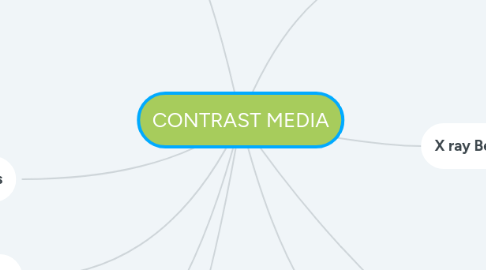
1. cause an increase in the attenuation of x-rays and are considered to be radiopaque
1.1. used to fill organs, they essentially make the organ radiopaque, and the image appears clear or white on the radiograph
1.2. classes of radiopaque contrast media
1.2.1. high osmolality ionic compounds (HOCA)
1.2.2. low osmolality ionic compounds (LOCA)
1.2.3. Nonionic compounds
1.2.3.1. combined effect of producing less anxiety in the patient
1.2.4. Plasma
1.2.5. Cerebrospinal fluid
2. Positive contrast agents
3. Recorded Image Contrast
3.1. This can be on film, or on stimulable phosphor plates or some digital media for digital radiography
3.1.1. one of the limitations of film for recording x-ray images is its relatively narrow exposure latitude or dynamic range
3.1.2. Image contrast is reduced or completely lost when the exposures are not well within the film latitude
4. Processed Image contrast
4.1. Both images recorded on fil and digital media undergo some form of processing before they are displayed as visible images
4.1.1. Film is chemically processed to convert the invisible recorded image into a visible image, some of the recorded image contrast might not be transferred into visible image contrast
4.1.1.1. ability to perform digital processing to enhance image contrast for specific clinical applications
5. Pharmacologic profile of contrast agent
5.1. Iodinated contrast
5.1.1. used for the imaging of anatomic boundaries and to explore normal and abnormal physiologic finding
5.2. Colorimetric contrast agents
5.2.1. fluorescent contrast agents (fluorescein)
5.2.2. methylene blue and indocyanine green
6. The contrast in an image on an electronic display or monitor digital radiographs, fluoroscopic images form of different brightness ratios between various points within the image area
7. negative contrast agents
7.1. will produce a greater radiographic density (darker image) on the image receptor
7.1.1. examples: radiolucent or negative, contrast agents are air, oxygen, carbon dioxide, and nitrous oxide
8. X ray Beam Contrast
8.1. The contrast in the attenuation image is represented by the difference in exposure among various points within the image area
8.2. For objects that attenuate more of the radiation than the adjacent tissue
8.3. 100% contrast is produced when no radiation penetrates the object
8.4. The amount of x-ray contrast produced is determined by the physical contrast characteristics (atomic number, density, and thickness) of the object and the penetrating characteristics (photon energy spectrum) of the x-ray beam
9. Displayed image contrast
9.1. optical density values between an object area and the surrounding background
9.2. Provide the capabillity for windowing
9.2.1. this allows the user to adjust and optimize the contrast in the displayed image
